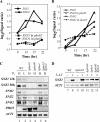Transcriptional repression by the Pho4 transcription factor controls the timing of SNZ1 expression
- PMID: 18408055
- PMCID: PMC2446651
- DOI: 10.1128/EC.00366-07
Transcriptional repression by the Pho4 transcription factor controls the timing of SNZ1 expression
Abstract
Nutrient-sensing kinases play important roles for the yeast Saccharomyces cerevisiae to adapt to new nutrient conditions when the nutrient status changes. Our previous global gene expression analysis revealed that the Pho85 kinase, one of the yeast nutrient-sensing kinases, is involved in the changes in gene expression profiles when yeast cells undergo a diauxic shift. We also found that the stationary phase-specific genes SNZ1 and SNO1, which share a common promoter, are not properly induced when Pho85 is absent. To examine the role of the kinase in SNZ1/SNO1 regulation, we analyzed their expression during the growth of various yeast mutants, including those affecting Pho85 function or lacking the Pho4 transcription factor, an in vivo substrate of Pho85, and tested Pho4 binding by chromatin immunoprecipitation. Pho4 exhibits temporal binding to the SNZ1/SNO1 promoter to down-regulate the promoter activity, and a Deltapho4 mutation advances the timing of SNZ1/SNO1 expression. SNZ2, another member of the SNZ/SNO family, is expressed at an earlier growth stage than SNZ1, and Pho4 does not affect this timing, although Pho85 is required for SNZ2 expression. Thus, Pho4 appears to regulate the different timing of the expression of the SNZ/SNO family members. Pho4 binding to the SNZ1/SNO1 promoter is accompanied by alterations in chromatin structure, and Rpd3 histone deacetylase is required for the proper timing of SNZ1/SNO1 expression, while Asf1 histone chaperone is indispensable for their expression. These results imply that Pho4 plays positive and negative roles in transcriptional regulation, with both cases involving structural changes in its target chromatin.
Figures




Similar articles
-
Nutrient-regulated antisense and intragenic RNAs modulate a signal transduction pathway in yeast.PLoS Biol. 2008 Dec 23;6(12):2817-30. doi: 10.1371/journal.pbio.0060326. PLoS Biol. 2008. PMID: 19108609 Free PMC article.
-
The highly conserved, coregulated SNO and SNZ gene families in Saccharomyces cerevisiae respond to nutrient limitation.J Bacteriol. 1998 Nov;180(21):5718-26. doi: 10.1128/JB.180.21.5718-5726.1998. J Bacteriol. 1998. PMID: 9791124 Free PMC article.
-
The regulators of yeast PHO system participate in the transcriptional regulation of G1 cyclin under alkaline stress conditions.Yeast. 2015 Mar;32(3):367-78. doi: 10.1002/yea.3064. Epub 2015 Feb 4. Yeast. 2015. PMID: 25582350
-
Partially phosphorylated Pho4 activates transcription of a subset of phosphate-responsive genes.PLoS Biol. 2003 Nov;1(2):E28. doi: 10.1371/journal.pbio.0000028. Epub 2003 Nov 17. PLoS Biol. 2003. PMID: 14624238 Free PMC article.
-
Transcription factors vs nucleosomes: regulation of the PHO5 promoter in yeast.Trends Biochem Sci. 1997 Mar;22(3):93-7. doi: 10.1016/s0968-0004(97)01001-3. Trends Biochem Sci. 1997. PMID: 9066259 Review.
Cited by
-
The nutrient-responsive CDK Pho85 primes the Sch9 kinase for its activation by TORC1.PLoS Genet. 2023 Feb 15;19(2):e1010641. doi: 10.1371/journal.pgen.1010641. eCollection 2023 Feb. PLoS Genet. 2023. PMID: 36791155 Free PMC article.
-
Biosynthesis and possible functions of inositol pyrophosphates in plants.Front Plant Sci. 2015 Feb 12;6:67. doi: 10.3389/fpls.2015.00067. eCollection 2015. Front Plant Sci. 2015. PMID: 25729385 Free PMC article. Review.
-
Nutrient-regulated antisense and intragenic RNAs modulate a signal transduction pathway in yeast.PLoS Biol. 2008 Dec 23;6(12):2817-30. doi: 10.1371/journal.pbio.0060326. PLoS Biol. 2008. PMID: 19108609 Free PMC article.
-
Life in the midst of scarcity: adaptations to nutrient availability in Saccharomyces cerevisiae.Curr Genet. 2010 Feb;56(1):1-32. doi: 10.1007/s00294-009-0287-1. Curr Genet. 2010. PMID: 20054690 Review.
-
Saccharomyces cerevisiae employs complex regulation strategies to tolerate low pH stress during ethanol production.Microb Cell Fact. 2022 Nov 24;21(1):247. doi: 10.1186/s12934-022-01974-3. Microb Cell Fact. 2022. PMID: 36419096 Free PMC article.
References
-
- Adkins, M. W., S. R. Howar, and J. K. Tyler. 2004. Chromatin disassembly mediated by the histone chaperone Asf1 is essential for transcriptional activation of the yeast PHO5 and PHO8 genes. Mol. Cell 14657-666. - PubMed
-
- Carroll, A. S., and E. K. O'Shea. 2002. Pho85 and signaling environmental conditions. Trends Biochem. Sci. 2787-93. - PubMed
-
- DeRisi, J. L., V. R. Iyer, and P. O. Brown. 1997. Exploring the metabolic and genetic control of gene expression on a genomic scale. Science 278680-686. - PubMed
Publication types
MeSH terms
Substances
LinkOut - more resources
Full Text Sources
Other Literature Sources
Molecular Biology Databases

